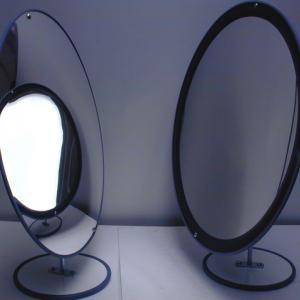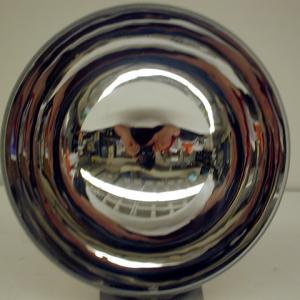College of Liberal Arts & Sciences
6A20.45 - Mirrors - Concave, Convex, Large Parabolic, & Store Mirror
Observe the images in the mirrors, and the focal point can also be calculated from the mirror curvatures.
- Hakan Isik, "Using a Smartphone Camera's Manual Focusing in Distant Optics Lessons to Learn Lens and Mirror Images", TPT, Vol. 62, #6, Sept. 2024, p. 501.
- Ariel R. Libertun, "Warning! Objects in Mirror Are Closer Than They Appear", TPT, Vol. 41, # 1, p. 20, Jan. 2003.
- James H. Andrews, "More Mirror Calculations", TPT, Vol. 41, # 4, p. 196, April 2003.
- Sam Lightner, "Which Mirror?", TPT, Vol. 41, # 4, p. 196, April 2003.
- "Editor's Note", TPT, Vol. 41, # 4, p. 196, April 2003.
- Hugo Graumann and Hans Laue, "Concave Liquid-Mirror Experiments", TPT, Vol. 36, # 1, p. 28, Jan. 1998.
- David Heiden, "Seeing the Light, an Alternative to Chalk Dust", TPT, Vol. 35, # 1, Feb. 1997, p. 94.
- Gordon P. Ramsey, "Reflective Properties of a Parabolic Mirror", TPT, Vol. 29, # 4, Apr. 1991, p. 240.
- James H. Andrews, "More Mirror Calculations", TPT, Vol. 41, #4, April 2003, p. 196.
- Sam Lightner, "Which Mirror?", TPT, Vol. 41, #4, April 2003, p. 196.
- Richard E. Berg, "Rotating Liquid Mirror", AJP, p. 280, Vol. 58, No. 3, March 1990.
- Fred M. Goldberg and Lillian C. McDermott, "An Investigation of Student Understanding of the Real Image Formed by a Converging Lens or Concave Mirror", AJP, 108, Vol. 55, No. 2, February 1987.
- O-150: "Diverging-Virtual Image Always", DICK and RAE Physics Demo Notebook.
- O-155: "Virtual or Real Image?", DICK and RAE Physics Demo Notebook.
- George M. Hopkins, "Light", Experimental Science, p. 210.
- C. Harvey Palmer, "Experiment A12: The Figure of a Mirror", Optics - Experiments and Demonstrations, John Hopkins Press, 1962
- "Spherical Mirrors", Selective Experiments in Physics, CENCO, 1962.
Disclaimer: These demonstrations are provided only for illustrative use by persons affiliated with The University of Iowa and only under the direction of a trained instructor or physicist. The University of Iowa is not responsible for demonstrations performed by those using their own equipment or who choose to use this reference material for their own purpose. The demonstrations included here are within the public domain and can be found in materials contained in libraries, bookstores, and through electronic sources. Performing all or any portion of any of these demonstrations, with or without revisions not depicted here entails inherent risks. These risks include, without limitation, bodily injury (and possibly death), including risks to health that may be temporary or permanent and that may exacerbate a pre-existing medical condition; and property loss or damage. Anyone performing any part of these demonstrations, even with revisions, knowingly and voluntarily assumes all risks associated with them.



